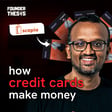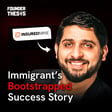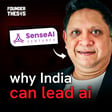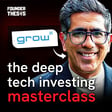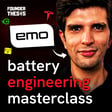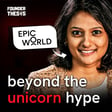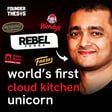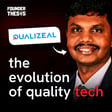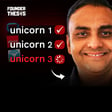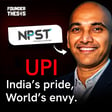00:00:00
Speaker
Take a minute. I'm dead. I'm dead. I'm dead. I'm dead. I'm dead. I'm dead. I'm dead. I'm dead. I'm dead. I'm dead. I'm dead. I'm dead. I'm dead. I'm dead. I'm dead.
Early Passion and Education
00:00:39
Speaker
Here is what happens when you add a dash of entrepreneurship to the magic of technology. You end up with a disruptive business venture and that is exactly what happened to Abhinav Jain, founder and CEO of Shop101. As a young boy growing up in Kanpur, Abhinav was fascinated with technology and learned to code at the age of 10. His pursuits landed him in the prestigious IIT Kanpur and eventually led him to start his entrepreneurial venture.
00:01:08
Speaker
Here is Abhinav telling Akshay Dutt about his time right after IIT Kanpur and his journey ahead.
Facing the Job Market and Pursuing an MBA
00:01:23
Speaker
So, IIT Kanpur, from there, where did you go? What happened around the placement season?
00:01:31
Speaker
Yeah, so it's interesting. This year, 2020, everybody talks about how it's not the best year to be in the job market or to be graduating from college. The year prior, which was similar, was 2009. And that was the year when I graduated. So it was a year when jobs were far and few in between.
00:01:54
Speaker
And you have to really struggle. You have to put fight for every single thing. And because you were at an IIT and you were doing well, of course, it was not that you would not get a job, that nobody would be willing to offer you a job. But basically, the question was, would the job, would it be exciting enough for you to do?
00:02:16
Speaker
In parallel, that year I wrote the CAD, did well, got an admission from IAM Ahmedabad. And I was like, hey, this is something that is exciting, will help me broaden my horizons. And also something that I realized that, you know, over the years, I had
00:02:33
Speaker
built a lot of skills around technology and and you know actually setting up systems but wanted to learn better on how to actually build organizations because building a product versus building an organization are two different skills right and and took up IMA went to IMA did two years of MBA and consulting was something which was very exciting for me because
00:02:58
Speaker
It was in some ways an extension of the education with smart people, where you work with senior folks, advise them, learn from them, and solve problems that make an impact
Experience at Bain & Company
00:03:12
Speaker
in the world, right? Make an impact on the company's organization and fundamentally in the world. So join Bain out of time in the world and spend four years at Bain. So again, the four years at Bain were
00:03:27
Speaker
Again, very instructive because one of the things that I realized is the best way to make the most out of and consulting experience is to have as diverse an experience as possible. So I would pick projects which were very, very different. So while I was technically part of the office in Bombay, I actually did very few projects that were out being run out of the Bombay office. I would be either in Delhi, Pune, Bangalore, you know, somewhere else in the country doing a project and projects range from
00:03:54
Speaker
I was in China or in Philippines. So my projects ranged from advising private equity clients on what investments to make to actually helping IT companies to actually helping an airline turnaround.
00:04:09
Speaker
to working with somebody who manufactures elastics for undergarments, right? From that niche to airline to IT to private equity. So did a very wide variety of projects and again, an experience that taught me a lot, learned from many different industries, many different people, and of course, created a lot of impact in parallel.
00:04:35
Speaker
So yeah, so that was my journey after IIT, the next few years after graduating from college. So what are essentially the skill sets that a consultant brings to the table for a client? Like is it that you have like a ability to crunch data and based on that, make recommendations? Is that what you offer to a client or I mean, you know, what is it that, you know, a good consultant gets to the table?
00:05:02
Speaker
Yeah, that's a question that I've always asked. And actually, the answer did not come to me when I was doing consulting. The answer came to me much afterwards when I was actually running my own company. The value prop became much more clear. So I think at different points and times, consultants bring different perspectives. One is the fact that consultants have the ability to be completely detached to the problem.
Role of Consultants in Problem-Solving
00:05:31
Speaker
They can come in with a fresh perspective and take a very objective approach to the problem and even the solution, which somebody who is part of the organization will find hard to do. That's one piece. Second is that I think in the organization,
00:05:52
Speaker
The people who are there, they have a very particular skill set. You could be an excellent marketer, you could be an excellent engineer, you could be an excellent person at procuring products or managing categories.
00:06:07
Speaker
But the skill set which the consultants bring is fundamentally, I think, is around structuring the problem and laying it out and connecting the big picture on the ground, which is not really what individual leaders are trained on when they are running functions, especially not across the board. And that skill set is very important because
00:06:35
Speaker
you will not have that within the team. And when you want to set up a new project or help with an existing project, sometimes when that skill set doesn't exist, it's just best to have consultants come in. And of course, I think consultants in general are much more suited for larger organizations where the problem becomes even more acute, where you have specialists, people who really specialize in that craft, but are not very strong at this general skill of problem solving.
00:07:04
Speaker
So there I think the value of a consultant is to bring in that holistic structure problem solving approach, marry the approaches seen in other industries and then come up with a solution that can be implemented in a very objective manner versus having vested sort of interest or parties involved. So 2015 you moved on from the end. So what was the thought behind making the move?
Return to Technology and Entrepreneurial Drive
00:07:29
Speaker
I think the thought was, as I described, very simple that, hey, it's time. Let's start building. And it's time to build. And of course, it helped that it was the time 2014-15 when a lot of activity was happening in the ecosystem. So that sort of gave me the nudge and the push that it is time. And in general, even within the consulting career, there are moments when you take a look back and take a pause and say,
00:07:59
Speaker
hey, do I want to do this further? Or do I want to do something else? And that was that logical time in that journey where I said, OK, now from here on, if I continue, it's on to the partner track. And then it's a few years again of consulting. Do I want to do that? Or do I want to go back to technology and start building? And the answer at that point came that, look, this is time. We need to start building. And so that was that. And while I would still recommend
00:08:26
Speaker
you know, then experience in consulting to pretty much everyone. But, but yeah, that was I felt that was the time when I needed to start building and go back to technology. Did you have a problem in mind or you decided to quit and look for a problem? So I did have the broad problem in mind. When I quit, I realized that I did want to work in the space of helping entrepreneurs. So that broad problem was there. But the exact solution on on how to build out a solution and sort of
00:08:55
Speaker
what precise problem to crack, that got more, that rectified once I had left my job. Okay. Okay. So tell me about
Founding Shop101: A New Business Model
00:09:06
Speaker
that, the journey of setting up shop 101, you know, like from quitting Bain to getting shop 101 off the ground, like what was that journey like? Yeah, it was interesting. Yeah. So first things, you know, to this question of did I have the problem before or did I quit my job before? It was very interesting because
00:09:24
Speaker
When I was sort of toying with this idea and thinking about, hey, I want to start out, everybody around me said, look, why don't you actually nail down the problem and then quit and then only leave your job? And I was trying to do that for a couple of weeks. But I realized that that just didn't work because for me, at least either I would not focus on my job at Bain, which was not something that I was used to either.
00:09:53
Speaker
If I did it, I had to do it well. Or I wouldn't be able to give enough time to solving the, you know, figuring out what I wanted to do. So while everybody told me, hey, you should figure out the problem and then leave. I basically one day went and put in my papers and came back home and told my wife, hey, it is, this is done. I have put in my papers and I called up my parents later that night. Hey, I left my job. I put in the papers and now my notice. I won't notice.
00:10:21
Speaker
And to me, my wife was working. And she's been super supportive. So she was like, OK, great. Let's do it. So my wife was working. She was super supportive. But that sort of was the key switch where I said, OK, this is it, that now you have to make this work.
00:10:46
Speaker
So that's what so that was the key moment. And then, you know, once you sort of start from once you've done that, I think then things begin to fall in place because you are yourself running. And then once you start running, you keep gathering momentum, keep getting people, etc. All of those things happen. So even before I left, I reached out to my co-founder and said, hey,
00:11:10
Speaker
Do you want to think about it, et cetera? And those conversations were... How did you know Aditya? So Aditya had known from... So I have two co-founders, Kalpak and Aditya. Aditya, I have known from my undergrad day that IIT Kanpur, we did computer science together back in the day. And Aditya had taken a different track. So over the years, he had done a different thing. And Kalpak, I had known from my being days, did a project together for a good eight, nine months early on.
00:11:38
Speaker
in 2011 or 2012 and I'd known him since then. So he had also left Bain but he was doing something else and you know and then the three of us sort of got together and yeah we started building this. So both of them came on at the same time or like all three of you together like brainstormed and came up with you.
00:11:59
Speaker
Yeah, so Aditya and I came together early on. Kalpak joined us. So Kalpak was actually running his family business. So he joined us, you know, a year or so into our journey. So he joined us later. But yeah. What project that you conceptualized with Aditya?
00:12:19
Speaker
Correct. So when we looked around us, Aditya had grown up in Baliya and different parts of Madhya Pradesh against small towns. And I had grown up like we discussed in different parts of UP. One of the things we realized is that India is fundamentally a country of entrepreneurs. As kids, we would always buy from these gutsy businessmen and entrepreneurs across the spectrum.
00:12:48
Speaker
But when we looked at the technological revolution that was happening around us, and we were here in Bombay, and we were looking at the massive change that was happening, very little was being built for this massive entrepreneurial class in the country. So even if I were to look at a Flipkart or a Snapdee, which were trying to build marketplaces, while on the consumer side, they were at least providing good access to the
00:13:16
Speaker
to the consumers, on the business side, it was still heavily concentrated. Very few businesses would get traffic, etc. And not much was being built. And we said, hey, how do we democratize entrepreneurship? How do we democratize access to technology? And that was the core problem we started with. And we said, look, social commerce is great because
00:13:39
Speaker
Social helps you democratize the access and commerce is the layer which we build, which we are good at. We know we understand technology. And why don't we bring this together and build a new model where we are able to leverage social media and democratize access for these entrepreneurs. So that was the crux of it, what we discussed and we said, OK, let's start building. And then, of course, as you keep building, you
00:14:08
Speaker
Keep going and then different things keep happening. So like give me more like a Product view that you conceptualize like what was the product you conceptualized for social commerce? Yeah, so Our first product was actually different. So while it was called shop under a one It was different in a car from from what it is today, right? So initially we said look our app will be such that it will help you Set up an online shop
00:14:38
Speaker
from a mobile phone at no cost, right? It will actually be a zero cost and it will
Growth and Features of Shop101
00:14:44
Speaker
set help you set up an online shop on mobile phone and it will come integrated with logistics, payments, et cetera, whatever you need, right?
00:14:52
Speaker
So you could just download the app and you could something like a Shopify for India with no subscription fees required and ready to go all plug and play. So you could like literally Akshay could set up a shop on their own.com slash Akshay shop and it would go live instantly. And it would have all logistics, COD, etc. all ready to go. And of course, very seamlessly plugged into the social networks.
00:15:19
Speaker
whether it was Facebook, Instagram, WhatsApp. And at that time, Instagram and Instagram commerce in India was on the rise. So with that, we started growing very well, right? In fact, our first, I still remember 4th of February, 2016. Till that time, we were signing up, you know, three, four new sellers a day, getting three, four orders a day, initial traffic.
00:15:43
Speaker
This one seller, he had come to us and met us and he sort of basically just wanted to make sure that we were not frauds because money would be flowing through us. So he just wanted to make sure of that. And he came and met us and then he set up his shop on our platform and put out the link at 8.30. And I was in office looking at the data and suddenly I see that
00:16:07
Speaker
within the next 30 minutes, we have 12 new signups and we have 10 orders. And that was the moment which told us, hey, this works as a social commerce, as a concept works. And we are here because this will not only drive transactions, but it will also help us drive growth. And that's how it started growing beautifully. Then over the next year,
00:16:33
Speaker
And what was your monetization for that? Like you were not charging any subscription fees? Correct. So at that point in time, the monetization was through services that you would use. So if you were using logistics, you would pay us. If you were using payments, payment gateway, you would pay us. So we would have a markup, right? So you would pay for things that you used. And that meant that the sellers were happy because they only had to pay when they were actually making money. And for us, it meant that we didn't have any
00:16:59
Speaker
you know people could get onboarded very quickly but once they started making money we also started making money so which was great our incentives were aligned in that sense right and money was flowing through us so we had no issue so that was great then over a period of time we realized over the next year or so that
00:17:20
Speaker
Another fundamental shift was happening in the country. You said that it was integrated with social. What did that mean? Like a seller could click on a button to post something on Instagram with a link to buy the product. Like, is that what it meant? Like he could upload a photo and shop. Correct. So that meant that we'd done a bunch of different things, actually. So for each of the things, so for instance, when you created a store on Chopin, it would actually
00:17:48
Speaker
ask you to log into your Facebook, and it would put in the link onto your Facebook page. So it would automatically be linked. When Facebook Messenger launched, we would help you set up an auto-reply on Facebook Messenger. So somebody pinged you, it would auto-reply, hey, here is my store. It would help you set up very, it would help you share very easily on WhatsApp itself.
00:18:16
Speaker
And similarly, on Instagram, you could set up an auto sync that whatever images that you uploaded onto Instagram would come into your ShopPandir 1 store. So that meant that whatever products you are putting there automatically came here and you could make them live. So if somebody clicked on the link in your bio, they would see all the products that were there. So did all of that and which meant that whichever channel you were using, you would be able to direct traffic to your ShopPandir 1 store very easily
00:18:45
Speaker
and actually drive transactions. So yeah, so that's what we. The early adopters were what kind of businesses?
00:18:54
Speaker
Yeah, so the early adopters were typically young people, age group of 18 to 30 themselves who were trying to hustle and would sell fashion and accessories as their predominant thing, right? So it could be some dresses, could be jewelry, could be some fashion accessories, could be shoes and a little bit of decorative items and home decor items as well.
00:19:22
Speaker
So, that was the initial set that we saw basically. And how were you acquiring them?
00:19:30
Speaker
So it was very interesting, right? Because as soon as people put out the link to a shop on their own store on their Insta page, not only did their consumers see other people in their community, their friends, other designers, other Instagrammers would see the link and they would download the app and sort of the cycle would start all over again. So it was a beautiful cycle where we didn't have to pay per se for acquisition, but as we kept going,
00:19:56
Speaker
More and more people just automatically started signing up. Of course, we would also do things to boost that rate where we would identify who were the top sellers on Instagram. And if they were not already on our platform, you would call them up and say, hey, here's a fantastic app. Why don't you use it? Look, so many people are already using it.
00:20:14
Speaker
It totally makes sense for you to use it. So it would do all of those hacks, but fundamentally people would look at other sellers and then join the platform. How the landscape changed over a year and about the pivot. As this was growing, this was great. The other change that was happening in parallel was that internet was becoming much more ubiquitous in India. Jio was launching, people fundamentally wanted smartphones were becoming cheaper and people were very keen on getting access to the internet.
00:20:43
Speaker
So, as that was happening, we realized that another set of
00:20:47
Speaker
so to say entrepreneurs were opening up in parallel, which was people who wanted to be entrepreneurs, but want, right? And the core access of technology and internet was solved for them. But what was not solved was the fact that Indian society is, you know, the way it is that women will face a certain issue. People are not, you know, having, while they might have all the
00:21:15
Speaker
to be an entrepreneur but still very conservative, access to capital is restricted, all of those challenges that we saw. And we saw that all those challenges had one underlying root cause, which was the fact that while people wanted to be entrepreneurs and we had solved the entire technology with the fulfillment, with the payment, with all of that, what we haven't solved for was the fact that this
00:21:38
Speaker
people who wanted to be entrepreneurs, didn't have access to products, couldn't keep inventory, hadn't figured out their supply chain.
Discovering the Reseller Model
00:21:46
Speaker
And we said, what if we solve that problem because we have all the paraphernalia to be able to do that? How would that work? But I mean, was this like a brainstorming exercise or did you actually have customers coming and telling you? So it was actually very interesting. It was neither. It was data which showed us that.
00:22:03
Speaker
So we saw that there was this one customer in Northeast who would order from this seller in Bombay very often.
00:22:16
Speaker
And we saw that same customer, same product transaction being repeated very often. And we were very curious as to what's happening. Because the early days, you want to figure out what are the trends and what's happening. And we realized, and once he spoke to this seller in Bombay, he said, oh, that customer in Guwahati is actually my reseller.
00:22:35
Speaker
So you were then intrigued, okay, what's happening? So he said, look, he's somebody who wants to do his business, but he does not have access to products there. So he orders on my store, whenever he gets an order locally, I ship it to him and then he delivers, right? And that's how the business works. You're like, wow. And then when we spoke to that guy, he basically, we understood that, look, this is already happening.
00:22:59
Speaker
Whether we solve it at scale or not, but this is something that's already happening. And then we realized that this could actually mean that you unlock entrepreneurship for a much wider audience. And that's when we sort of got into it with full zeal on building out the supply side of things, on the supply chain.
00:23:23
Speaker
While we built out, we got a few suppliers on board fairly quickly and we were able to do that. The challenge we faced is that our initial thesis of how just the product should look like, that didn't work. People were not able to figure out what the supply is, how to start selling, et cetera. And then we did another overdo of our product where we changed to like a full feed-based approach where the discovery of products for these resellers became much simpler.
00:23:52
Speaker
And then that just took off. That just meant that pretty much we had unlocked. Anybody could be a reseller without any investment, without any effort, and without even any prerequisite skill set. All you needed to do was figure out what would work in your community, in your network, curate those products, and share. And that's it. And we would take care of everything. We would take care of the logistics infrastructure,
00:24:17
Speaker
Cash and delivery services all of that and and make sure everybody got their share of money, etc So it became very very simple and and and that was that just took off like crazy So yeah, so so that's that's the after you find shopping around in today So building a supply is like no longer a tech problem I mean, you know to then it means that finding vendors who have good quality products having some sort of
00:24:43
Speaker
quality control over products because your sellers would not want to sell something which gets a bad review from a customer or things like that. So, you know, then how did you solve this problem of building a supply? Like, I mean, Flipkart and Amazon have like spent years and years to solve that problem. Absolutely fair. So the way we look at it is it's a tech plus sourcing problem. The reason why I say that is that we underwent
00:25:13
Speaker
a transformation in that sense, but where we built out the entire sourcing and supply side team,
Enhancing Supply Chain and Operations
00:25:19
Speaker
right? We actually got in people who had built these categories before, set up the paraphernalia and set up the infrastructure, both not physical per se, but technology and the people infrastructure to actually be sourcing these products, right? And to your question on actual quality and trust,
00:25:38
Speaker
Then we built out very robust tech-led processes which ensured that we are able to deliver the quality and trust. So as an example, when we set up the entire sourcing piece, we said some of the calls we took is that
00:25:55
Speaker
A, for a supplier to be onboarded onto a platform, we would actually go and vet them even before they could be onboarded. So we let all suppliers who come onto our platform. And it can be a very simple thing that, OK, what's your business history? What's your investment that you've gone in? What's your market cred, et cetera. And you run those checks. So that's just pre-onboarding itself. We have a very strong quality control criteria. Then even once the person who's onboarded on the products have been listed,
00:26:25
Speaker
are the tech piece kicks in, where on one side, the customers and the resellers are actually uploading reviews and real products, real images of the products onto the platform. So it is very clear that the product that was delivered, how different or similar is it to the product that was promised and what's the rating and review. And basis that we run a very stringent check on, you know,
00:26:51
Speaker
which supplier should continue, how much visibility every supplier should get, and the better your ratings are, the more visibility you will get. And of course, below a threshold, you ask to leave the platform. So that entire thought process
00:27:08
Speaker
made sure that we were able to scale the supply side without having to build a very, very large team. I would say that we've been able to do that in a very frugal way in the way we've built our team and build the product to actually manage the entire fulfillment and on-sourcing and onboarding of products.
00:27:30
Speaker
So how do you handle the warehousing and fulfillment? Like you have partners who take care of that? Yeah. So what we've done is there are seven large or eight large logistics players in the country and we are basically tied up with all of them. We follow a just in time inventory model, so we don't warehouse anything. We just make sure that the inventory on the platform is marked accurately by the suppliers.
00:27:56
Speaker
And then the product is picked up in real time from the supplier delivered to the end consumer. And in case there is a return, it is returned back to the supplier. So we don't hold inventory, um, anywhere, uh, in the, in the chain. It's picked up from the supplier delivered to the end consumer or returned back to the supply. Okay. Okay. So when you decided to build a supply, like what categories did you start with? You know, how did that progress? So I think the categories themselves were picked.
00:28:25
Speaker
the initial categories that I spoke about, I think those were the categories which are fundamentally suited to social commerce, except for the fact that our ethnic and ethnic fashionware became a much larger part. Other than that, fundamentally, the categories remained the same. It was fashion, apparel, footwear, accessories, home decor, kitchen items, and beauty, personal care. And we just stuck to that set of products. And we stayed away very,
00:28:53
Speaker
very actively from electronics and smartphones where you cannot, there is no real value to a reseller getting in, in general, and there is no money to be made. Right. So, so we, we, we stayed away from those. And these were like branded products, like say, if you have kitchenware, then was it like a prestige and all that, or was it like? Typically the value of, of the reselling model is in unbranded long tail items. Basically these are unstructured categories and unbranded products.
00:29:23
Speaker
Because the thing is that in India, you know, this is a play which is going to, as I was explaining, we are democratizing it for the billion people, for people across the country. So tier two, tier three, it's not as much about looking at brands, but it's a lot about being, you know, value for money, being very price effective.
00:29:47
Speaker
The value of the model is this that are you able to connect or match the right product to the right consumer at the right price? And which is where this entire thing around how we curate our supply, how then the resellers are able to curate their collection for their end consumers and the trust on the reseller comes in. So long story short, we provide discovery to long tail products.
00:30:12
Speaker
And that's our strength. So typically these are unbranded items and products which you actually see in everyday consumption in the country. For the resellers who are on the platform, then when they like a product and they think they can sell it, then how does it happen? Like with they first add it to their store or their shop front and then they advertise it. Like what is the flow that happens then? So typically resellers will post it on a Facebook or an Instagram or a share chat or a TikTok, wherever they have to post it. Right.
00:30:41
Speaker
And the way it works is that every reseller will curate a certain set of products that they believe will work. And usually, you typically don't share just a single product. You will share a few products. And you will share that with your customers. And then they will come back, hey, I like this. And the beauty is that it has the possibility of a conversation.
00:31:04
Speaker
Unlike any other platform, any other commerce platform here, the consumer will say, hey, I like this study, but do you have something which is a little more simpler? Or do you have something which is a little more cheaper? Or this study works well for a birthday party, but guess what? I'm looking for something which I can wear to office tomorrow.
00:31:24
Speaker
So then that conversation happens, the reseller has the ability to curate more products, showcase the right product and then close the transaction. And the reseller also has the ability. So there's like a chat interface. Yeah, there's like a chat interface and that chat interface is not even on our platform. It's so interesting how different people have adopted the model.
00:31:47
Speaker
You know, the most common, of course, is WhatsApp, given its people leverage that. But we have found stories like in terms of the interface. Just to give you an example, we went and met this lady in Chennai, and we were wondering how does she do business. And we keep doing visits to our resellers' place and understanding what are they doing. So this is a lady, 50 years old plus,
00:32:14
Speaker
her kids are doing her own thing. So we asked her, how do you sell? And in fact, she couldn't speak English. So my colleague was talking to her in Tamil and asked, how do you do this? So she said, OK, hold on. She went in. She got out like a set of papers on a clipboard. And we were like, what is this? So this is a clipboard. If you recall, when you used to write exams as kids, you would have that on which you could just stack a sheet of paper and take it.
00:32:43
Speaker
So she then explained, I have a group of people who I meet in church. So what I do is I will send them photos on WhatsApp and then because we can't really type on WhatsApp and we can't communicate. So when I go to the church, they will show me the photo and I will note down the product code and the price that I promised them and come back. And then later in the night, I will look at my set of papers that I got and then I will punch the orders on the app and then they will get delivered.
00:33:11
Speaker
Our mind was blown. What do you call this? This is technology, person to person selling. It's a combination. So the sellers typically punch in the orders themselves or they give a link to a customer and the customer orders. What is the more common behavior? So both modes exist, but typically it's the seller who punches the order. Because that's the beauty that you have the ability to discuss, negotiate,
00:33:38
Speaker
suggest more products, negotiate the price, all of that is possible. And the seller can put the address of the customer for delivery there, so it directly goes to them. And the cash is picked up by the logistics partner. So essentially, this is adding a layer of technology to the traditional way in which small entrepreneurs have been selling for so many years. Correct. Absolutely.
00:34:07
Speaker
So it's a layer of technology which opens up a full world of products to them.
Empowering Entrepreneurs with Technology
00:34:15
Speaker
In the traditional way, if a small entrepreneur wanted to do business, they would have to stock some products, which would be 10, 20, 50, depending on the range that they could stock or afford. Now here,
00:34:26
Speaker
The stock is basically unlimited, right? You have unlimited SKUs that you want, which means your ability to sell is much stronger. The customer is happy because the reseller is not trying to just give any product that they have. They're truly trying to understand what the customer wants and solve for the customer. So it makes a lot of sense for both parties in this case because the reseller is able to make much more money.
00:34:51
Speaker
The customer gets what they want and imagine this for a customer, it's almost like a personalized shopper that they get and they get to browse products out of their choice at home. So it's like the behavior in which people used to say, let's go to the market.
00:35:07
Speaker
that has come to their phones now. And even that collection is curated for them. So it's a win-win for everybody. So don't sellers feel insecure that if I tell a customer, visit my store on Shop 101, then they will also see all the other stores there. So basically, the stores that we provide are on a different domain name, which is an independent domain name.
00:35:32
Speaker
And so there is no link really to Shop 101 or the consumers don't even know that the seller is getting the products from Shop 101. So the reseller is very safe and assured. In fact, to that point, we host these on our other product, which is called Dash 101.
00:35:52
Speaker
which is a full solution to create web stores, etc. So the consumer doesn't know whether the seller is uploading the products themselves or getting it from somewhere else.
00:36:03
Speaker
Dash101 is the original business that you started of Shopfront. So come 2020, we realized that the original Shopfront piece and the fact that we are providing logistics as a service, it's now becoming that need is very, very high. And while we always continue to offer that solution under the original brand, but
00:36:28
Speaker
It's hard to discover two different parts of a solution, especially when you talk about one a lot more. So we said, OK, why don't we build this out of the full solution under a new brand name, and we launched it under Dash 101. So Dash 101 is a full-stack e-commerce platform where you can set up an online store and start a business. And you can scale it with world-class logistics, which is seamlessly integrated payments
00:36:56
Speaker
And it just works, right? And we are very happy if you also want to use just one part of a service. So for instance, maybe you already have a website on like we discussed a Shopify, you can just use the logistics part of our ecosystem and you will be able to very seamlessly run it. And it's, you know,
00:37:13
Speaker
We have all the optimizations built into our service, so we will help you understand which orders have a higher probability of returns, which you should fulfill or not, etc. So we've built all of that thought and our expertise into the product itself. So the Web Store is optimized for conversions. The Logistics Service will help you understand
00:37:38
Speaker
which orders are most likely to be profitable or which orders are most likely to be returned. So we will help you do that. Okay. So like in logistics, you would also have intelligence around like which pin codes have like fraud possibilities or stuff like that. So in fact, we've gone beyond this pin code, we will actually tell you that on an order level.
00:37:57
Speaker
So we will tell you on a pin code pair level, which shipping partner to use, which is the best bet for this set of pickup and drop in codes. And we would also tell you on an order level, what is, if you should be shipping this order or not. Like if it's a high probability of a return order or what. So that is based on the product or the location. So that is based actually on both. So we bake it and bake both. And also it is also based on the way you input the address into the platform.
00:38:28
Speaker
Because as you can imagine in India, a lot of times people will also write things like, bus stop, call me from the bus stop. And that's just the brush. And then what have you got? So it's a very unique market where you operate. When does the seller get the money?
00:38:48
Speaker
Yeah, so in terms of the if it's a reselling order where you've taken the products from us, we have a standard five day return window. So after the money has been collected from the end consumer, we wait for five days in the five days, if the consumer has any issue, they can raise a return request, we'll pick up the product back and refund the money. And if not, if once the five day window has elapsed, we will basically transfer the money to the seller to the bank account. Like his his margin. Yeah.
00:39:15
Speaker
He shares it to his or her bank account and the suppliers share to the suppliers bank. So if there is a return, then whose cost is that? Does the seller bear the cost or who bears that cost? If there is a return, no. So to the reseller, we keep it very simple. We say, hey, for you, we have no cost. As long as you are doing business in good faith, and it's not like every product that you get, you are returning. You're doing business in good faith. You have no cost. We've given you full.
00:39:45
Speaker
all-inclusive cost in upfront itself and you can just go and do your business and that's what we do. So that cost is borne by us and of course there's a cost structure that we have with the supplier as well. So depending on what the understanding with the supplier is
00:40:18
Speaker
So what is your current customer acquisition strategy? So initially when you started at that time people were going to shop one-on-one and
00:40:27
Speaker
Therefore, there was an inbuilt advertising anytime someone was selling. But now that they are going to a different domain, so what is your current strategy to acquire more resellers?
Marketing and Reseller Engagement
00:40:40
Speaker
Now the strategy is slightly different, but it's still very, very interesting and very unique in its own way.
00:40:51
Speaker
Now, the strategy is a lot around reaching out to people ourselves, which is whether through digital or paid marketing or through influencers or through referral programs. But something very interesting happens when we do this marketing today. Fundamentally, when a typical e-commerce platform markets, they say, hey, I am selling this product, buy this from me. And that's the way to reach out to a new consumer.
00:41:19
Speaker
And it has its associated cost, whatever the customer acquisition cost you get. Now, when we market, we say, hey, here's the way to change your life. Here's the way to make money. So as much as we are trying to reach out to these resellers, people are fundamentally looking for ways to make money. So in fact, if you look at my Google Play store listing, it will talk about on money from home, work from home jobs, because that's what people are searching for.
00:41:47
Speaker
And which basically means that we can, while we are trying to do all of these things to reach out, people themselves are looking for us. And which means that we can acquire these reseller data actually at a lower cost of acquisition than even the customer acquisition cost of other platforms. So if other platforms acquire a customer at, say, 500 to 1,000 rupees, we can do that at a couple of 100 rupees, or even at 100 rupees, which is an order of magnitude lower.
00:42:16
Speaker
Every reseller is getting their own network of consumers. So which means that the actual cost of reaching out to one consumer is significantly lower than any of the traditional platforms. And which is what explains why we've been able to ramp up and build out our network in tier 2, tier 3, tier 4, and even in smaller towns at a very fast rate. Initially, did you self-fund it? When did you look for external funding?
00:42:42
Speaker
So yeah, it was very interesting. Like I said, when we were starting out, once you decide that you have to do it, then things start falling in motion. And in parallel, as we were laying out the initial problem, et cetera, I was talking about the problem to my friends. And one of my friends works for
00:43:04
Speaker
fund called VY Capital and he said look this problem looks interesting we've already been looking at companies in the space and if you are going to do it why not we would love to partner and you know let's start some more and that happened and so while we were launching our initial product this conversation also rectified in parallel and yeah so we got funding very early in the day.
00:43:29
Speaker
And after that, like how many additional what was the funding you raised in that round? And then how much did you raise subsequently? Like what was that journey like? So that initial funding was such that it was more of a, you know, so the first check was for a million dollars. And then it was that let's see how it goes and we can fund you up to, you know, a few more million dollars and we can do that. But the first step was that.
00:43:55
Speaker
And then subsequently, of course, over a period of time today, we have raised about twenty two million dollars in total. And, you know, from that round, we raised a CDZ, CDZB, CDZ. So that's how we've raised. So we've raised twenty two million dollars in total. And yeah, that that journey, you know, the thing about funding is it's almost like it's it's it's fuel to to to to run the race.
00:44:24
Speaker
But you have to still build on from there.
00:44:31
Speaker
So yeah, so that's at least our philosophy in terms of how we look at capital and, you know. So is fundraise like a full-time activity for one of the founders? Is it like you get a lot of inbound interest and it's easy to do or is it like there is constantly work happening on that front also in parallel to building the product and acquiring customers? So I think it's a very interesting thing. So the way I look at it is I think
00:45:01
Speaker
It is a full-time thing, like it's on full-time. When you're not actively fundraising, maybe it takes 20% of your time. And when you are actively fundraising for one of the founders, it does take up 60 to 80% of your time. So it is at least at the time when a round is open and you are actively raising,
00:45:23
Speaker
At that point in time, it does take up a significant part of the bandwidth for one of the founders for sure. So how did you develop the skills to fundraise? You know, I mean, that itself is like a skill that a lot of founders are unable to succeed because they lack that skill. So, you know, how did you develop the skill between the three of you? I think the only way to develop the skill of fundraising is just like a sales skill, which is just do it.
00:45:52
Speaker
You have to just, I think half of it is just about showing up and being at it every day, every meeting and so on. And the other half I think is learning from every meeting. So it would be a shame if your first pitch is as good or as bad as your last pitch. Ideally, if in a set of two weeks, three weeks, four weeks or whatever timeframe you have,
00:46:20
Speaker
say 10, 15 meetings, your 15th meeting should be significantly better from your first one. And that's because you are the same person, your business is still the same, but you know what answers to expect. You have all the data in the tip. You know what questions to anticipate and how to guide the conversation and how to make sure that your strengths are being highlighted. So I think that's just the skill set to continuously keep improving.
00:46:49
Speaker
And if you do that, I think, and of course, fundamentally, if you build something that is valuable, that makes sense, then people will be willing to fund you. See, at the end of the day, an investor is looking to answer just one very simple question. Can I trust this guy and can I trust this team to deliver what they're saying? And you have to figure out, how do you help people trust you? That's it.
00:47:17
Speaker
And there are many components to it. Is the market big enough? Is the opportunity size big enough? Is the team great? What have you executed in the past? And how do you communicate all of that to deliver that trust? So I think at the end of the day, you are trying to just make sure that the person can trust you with the money. And that's pretty much what it is.
00:47:39
Speaker
What works in fundraising? Does cold calling work or did you get benefit from the alumni networks of your two institutions? Typically speaking, what are the things that work? If you're cold calling, you are setting yourself up for a harder path than you should.
00:48:02
Speaker
If you, you know, like you said, the alumni network, and even just the founder network, or even just the fact that you've been, you know, in this space, you will be able to find a connect to pretty much all investors very quickly, or at least with a little bit of hard work. Right. And that always helps where at least you are going in with some connect to the investor. Of course,
00:48:29
Speaker
a cold call is better than no call at all. So of course, if you don't know somebody, absolutely by all means cold call them. Otherwise, you know, try and figure out the connect and it could even be, you know, you met one investor and they said, hey, this is something which is not for us for whatever XYZ reason, but I think this would be interesting for another investor.
00:48:54
Speaker
You know, just ask them for that intro. Hey, can you make that quick intro? Because even if that is happening, that means that somebody else is saying, Hey, I looked at them. It makes a lot of sense for you. Why don't you take a look as well? And even that intro works. So the point is that can you get that connect whichever way possible? What kind of numbers are you seeing on the platform right now?
Impact and Reach of Shop101
00:49:23
Speaker
Yeah, so what's interesting is we see lacks of active resellers. And when I say active resellers, people who do transactions on the platform right now, and which goes on to the fact that, you know, we've solved for a problem which exists, which is a very widespread problem, right? People looking to make money and people looking to also respect in some ways.
00:49:51
Speaker
So and which is reflective in the fact that lots of people want to do this and are actually able to transact on the platform. So that's where we are. And then these lots of people are actually able to reach at the last count, we checked that we were able to reach about a few million end consumers, which is about tens of lakhs of end consumers.
00:50:19
Speaker
So clearly, the problem is a massive problem to solve, plus also the fact that these resellers are actually able to reach a very wide base of people at basically no significant cost to them. So the network is being built very, very rapidly.
00:50:41
Speaker
So your end customer acquisition cost is not there basically. Your cost is only to acquire resellers. How much do you earn on an average per reseller? Except for the reseller, the top guys can earn more than a lakh, right? A month. And of course, this is the top guys I'm talking about. But if you hustle, you can definitely earn, you know, like
00:51:08
Speaker
The top 5-10% would be earning in thousands per month.
00:51:18
Speaker
at it are willing to hustle willing to put in the time and effort or provide superior customer service to their end consumers and their end consumers like to talk to them so that so it's truly up to the reseller on how large can they become because even like in the Diwali season itself we had run like a Lakhpati offer
00:51:39
Speaker
And apparently the winner is getting, other than the lakh rupees of price that she would get from us, she would have earned a lakh rupees during the Diwali season just from her sales. So her annual income, if you want to see, would be a lot. So I think the platform is truly democratic in the sense that it does not differentiate between who you are, where you come from, what you have done before. All that matters is what are you willing to put in today? What is the hustle that you're willing to put in today? What is the effort?
00:52:09
Speaker
and we are there to support everybody. So I think the earning totally depends on how the resellers are putting in the effort. Now what's even more interesting is the way we've built the platform, not only does the reseller make money, actually we also make money. So one of the very different things that we have done fundamentally as a company is to make sure that, is to build a sustainable business. So we are very proud to say that
00:52:40
Speaker
We are we will be one of the very few commerce companies in India who actually make a contribution margin after accounting for all discounts for all bonuses incentives and marketing costs. Right. So people talk about how they make money on a unit level. We of course do that. But we also make money on our economics on our after accounting for all our marketing discounts, bonus incentives, etc.
00:53:07
Speaker
And which is very powerful because what it means is that you are able to actually build a business which is fundamentally sustainable and both for the reseller as well as for the platform. And that's been our goal ever since.
00:53:28
Speaker
to make sure that we build it in a manner that's sustainable for everybody. So what has been the impact of COVID for you? So COVID was, you know, the month of March and April was very tricky because at that point in time, e-commerce was fully on pause in India pretty much other than the essential goods.
00:53:48
Speaker
And so that meant that our business was pretty much on pause. We did use that time to do a bunch of other things, but we had to build back from there. Having said that, while we had to build back our business from pretty much being on pause for a month or so,
00:54:06
Speaker
We use that time very well. One of the things that we did was to experiment during that time with digital products. And we tried a bunch of things like mobile payments, recharges, education, courses, etc. And we built our learnings there and we figured out what can work through the model right now and what can work maybe at a later stage. And that was very instructive.
00:54:33
Speaker
So this like mobile payment recharges like so your seller would be able to recharge phones for her customer base. That's right. That's right. And we were trying and we were trying to see how that works and what are the challenges that we face and we leverage that time. So that was that was one set of things that we did. The other thing that we did during that time was to also put a focus on, you know,
00:55:01
Speaker
becoming a profitable and unsustainable business much faster. So we spent that time building the models that I was speaking about earlier, the data models where we can recommend which orders are fraud or which orders will be delivered, what shipping partners to use. So we spent a lot of time building those, our inherent core infrastructure, core
00:55:24
Speaker
IP during that time and that helped us very well because when as we were ramping up even though sort of the you know the lockdowns did not come off in one go it was in patches in bits and pieces with a lot of local underground challenges but because we had that infrastructure in place already it meant that we as we were opening the business back we were not losing money even at that time.
00:55:46
Speaker
So we were able to come back very strongly and today we are at that stage where businesses are continuing to grow back and the margin is also improving and growing because we took that time and spent that time in building the underlying infrastructure. In terms of your month-on-month top line, has that gone back to pre-COVID level now?
00:56:09
Speaker
In certain categories, it's beaten pre-COVID levels. In certain categories, it is yet to get there. So for instance, categories like home decor and beauty, et cetera. There, at least in these two categories specifically, our top line is actually much higher than before. But say in other categories like women's ethnic wear or apparel, et cetera, they are in apparel.
00:56:35
Speaker
There, the top line is yet to meet the pre-forward levels. So it's a mix. In certain cases, we... Overall, aggregate is getting there. It is close to there, yet to touch the peak point. The categories again would reflect a new normal, more work from home, so people wouldn't be quite close to wear out. Correct.
00:57:01
Speaker
And which is interesting that, you know, as specific season sort of rolls in, that will also change. And because now we will also see a wedding season which will come in now, given the last few months have seen very few weddings. So now apparel and clothes will also start, you know, sell a lot more because also along with winter wear, which also anyways is. What is your headcount like? So we have about 250 to 300 people right now.
00:57:27
Speaker
And you're like in Mumbai, all these people are in Mumbai? Pretty much, but because they are all in Mumbai, but because you're all working from home, you could be working from pretty much anywhere in the country right now. So a lot of the people who don't originally hail from Bombay,
00:57:44
Speaker
Are working from different parts of the country and that's fine because till the time we don't go back to office I think it's just best that everybody is comfortable and the split of these 250 people like in functionally like yes a Significant part of this about would be close to about a hundred people would be in our sourcing and category management team right, which is just running the the actual part of getting new products on board and
00:58:12
Speaker
Then there is another set is around the logistics operations, call center support, right? That would be another close to about 75 odd people.
00:58:25
Speaker
And then there is the other part is the entire technology, product, data science, design team, which is another one, 70, 75 people. But I guess your customer service need like, you know, per customer basis would be lesser, you know, because in a way your resellers would do custom. Absolutely. Absolutely. So our customer service is basically to the reseller is to resolve the issues for the reseller so that they can
00:58:50
Speaker
you know, make sure that we are able to provide a fantastic experience. What do you see as, you know, like say a five-year roadmap for Shop101? The way we see it is, look, we are here to democratize entrepreneurship and to make sure that we are able to create and grow entrepreneurs in the country,
Vision for a Comprehensive Business Ecosystem
00:59:09
Speaker
right? Five years down the line, the way we see Shop101 and even Dash101 together, right? Is the fact that
00:59:16
Speaker
If anybody wants to open a new business, all they need to do is plug into our ecosystem and they get everything here, right? Whether it's an online shop, whether it's the logistics, whether it's the payments infrastructure or even access to the supply chain. All of that exists here, right? All you need to do is just open a shop and do your magic on top of that. And all the underlying infrastructure is just here for you. Your closest competitor would, I guess, be someone like Amishu.
00:59:48
Speaker
So our closest competitor, if you were to just look at the supply chain side would be like would be Misha. But if I were to look at this entire infrastructure that we've built where you have a full online shop, the ability to run your logistics payments, take supply from us. That as a full platform that we've built.
01:00:08
Speaker
Actually, nobody has done that before. Either people have come at it from saying, hey, I want to build an online shop, or I want to provide payment service, or I am a logistics player, or I am a supply provider.
01:00:19
Speaker
But somebody building it together into an infrastructure that entrepreneurs can just move up the shelf, that really hasn't been done before. So Michu doesn't provide the supply or like what are the things that Michu doesn't do? Just you have the supply, you can post it on Instagram, Facebook, etc. But you don't have a bookstore. You cannot set up a shop in that sense. Right. And imagine if you want to run a mixed model where maybe you are making jewelry at home and you take sardines from my supply. You really can't run that.
01:00:45
Speaker
But Michu has raised a significantly higher amount of funding. So is that something you see as your biggest threat out there? Or what are the things you see as threats? See, I think the biggest threat fundamentally that I think is the mindset of people which doesn't want to change. That's the biggest challenge I've faced.
01:01:11
Speaker
when we sort of have built the solution. I mean, the question to ask today is that, why are there only lots of people on my platform? Why is the number not in crores? When we know for a fact that there are many more people who would be benefiting from such a product, right? So to me, that mindset of how do I drive change or mindset of not wanting change, I think is the biggest challenge.
01:01:39
Speaker
And that's what we actively try and from our side make the product extremely simple. Try and find voices which will help convince people that it's extremely simple and trustworthy to do and you can get started. And that's the challenge that we work against predominantly that how do you make sure that the product is so, so simple that there is really no friction or really no barrier for somebody to get started on that. And because if you do that,
01:02:08
Speaker
And you have a sustainable business model, then it doesn't matter what else is happening in the world. Then you've solved both sides of the problem. You've made it easy and simple for people to adopt. And you've made a business model which actually works really well.
01:02:32
Speaker
So that was up enough, talking about setting up Shop 101. If you would like to know how reselling works or are looking to sell your products online, log on to shop101.com.
01:02:50
Speaker
If you like the Founder Thesis Podcast, then do check out our other shows on subjects like Marketing, Technology, Career Advice, Books and Drama. Visit the Bodham.in that is T-H-E-P-O-D-I-U-N dot I-N for a complete list of all our shows.

